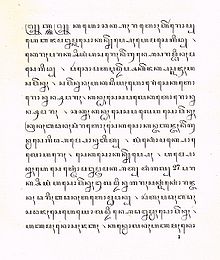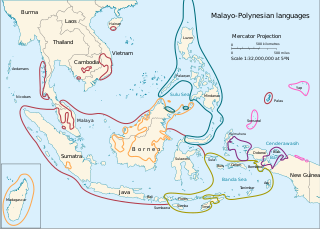
The Malayo-Polynesian languages are a subgroup of the Austronesian languages, with approximately 385.5 million speakers. The Malayo-Polynesian languages are spoken by the Austronesian peoples outside of Taiwan, in the island nations of Southeast Asia and the Pacific Ocean, with a smaller number in continental Asia in the areas near the Malay Peninsula, with Cambodia, Vietnam and the Chinese island Hainan as the northwest geographic outlier. Malagasy, spoken on the island of Madagascar off the eastern coast of Africa in the Indian Ocean, is the furthest western outlier.

Madura Island is an Indonesian island off the northeastern coast of Java. The island comprises an area of approximately 4,436.77 square kilometres (1,713.05 sq mi). Administratively, Madura is part of the province of East Java. It is separated from Java by the narrow Madura Strait. The administered area had a density of 755.6 people per km2 in mid-2023, while the main island had a somewhat higher figure of 840 per km2.

Sundanese is a Malayo-Polynesian language spoken in Java, primarily by the Sundanese. It has approximately 32 million native speakers in the western third of Java; they represent about 15% of Indonesia's total population.
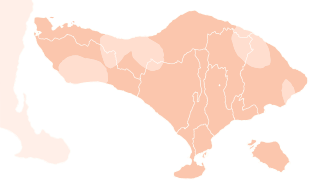
Balinese is an Austronesian language spoken on the Indonesian island of Bali, as well as Northern Nusa Penida, Western Lombok, Southern Sumatra, and Sulawesi. Most Balinese speakers also use Indonesian. The 2000 national census recorded 3.3 million people speakers of Balinese, however the Bali Cultural Agency estimated in 2011 that the number of people still using the Balinese language in their daily lives is under 1 million. The language has been classified as "not endangered" by Glottolog.

Javanese is a Malayo-Polynesian language of the Austronesian language family spoken primarily by the Javanese people from the central and eastern parts of the island of Java, Indonesia. There are also pockets of Javanese speakers on the northern coast of western Java. It is the native language of more than 68 million people.

Old Javanese or Kawi is the oldest attested phase of the Javanese language. It was spoken in the eastern part of what is now Central Java and the whole of East Java, Indonesia. As a literary language, Kawi was used across Java and on the islands of Madura, Bali, and Lombok. It had a sizable vocabulary of Sanskrit loanwords but had not yet developed the formal krama language register, to be used with one's social superiors that is characteristic of modern Javanese.

Makassarese, sometimes called Makasar, Makassar, or Macassar, is a language of the Makassarese people, spoken in South Sulawesi province of Indonesia. It is a member of the South Sulawesi group of the Austronesian language family, and thus closely related to, among others, Buginese, also known as Bugis. The areas where Makassarese is spoken include the Gowa, Sinjai, Maros, Takalar, Jeneponto, Bantaeng, Pangkajene and Islands, Bulukumba, and Selayar Islands Regencies, and Makassar. Within the Austronesian language family, Makassarese is part of the South Sulawesi language group, although its vocabulary is considered divergent compared to its closest relatives. In 2000, Makassarese had approximately 2.1 million native speakers.
Javanese script is one of Indonesia's traditional scripts developed on the island of Java. The script is primarily used to write the Javanese language and has also been used to write several other regional languages such as Sundanese and Madurese, the regional lingua franca Malay, as well as the historical languages Kawi and Sanskrit. It heavily influenced the Balinese script from which the system for Sasak developed. Javanese script was actively used by the Javanese people for writing day-to-day and literary texts from at least the mid-16th century CE until the mid-20th century CE, before it was gradually supplanted by the Latin alphabet. Today, the script is taught in the Yogyakarta Special Region as well as the provinces of Central Java and East Java as part of the local curriculum, but with very limited function in everyday use.

Madurese, Madurans, Madurites or Madurace are one of the Javan ethnic groups native to the Indonesian island of Madura in Java Sea, off the northeastern coast of Java. They speak their own native Madurese, sharing a common history, traditions, and cultural identity. Nationwide, the Madurese are the third-largest ethnic group in Indonesia, and one of the well-known Indonesian national dishes, Satay, is attributed to the Madurese as part of their culinary heritage.

The Sasak language is spoken by the Sasak ethnic group, which make up the majority of the population of Lombok, an island in the West Nusa Tenggara province of Indonesia. It is closely related to the Balinese and Sumbawa languages spoken on adjacent islands, and is part of the Austronesian language family. Sasak has no official status; the national language, Indonesian, is the official and literary language in areas where Sasak is spoken.
Bhutia is a language of the Tibeto-Burman languages spoken by the Bhutia people in Sikkim in northeast India, parts of Koshi province in eastern Nepal, and Bhutan. It is one of the official languages of Sikkim.
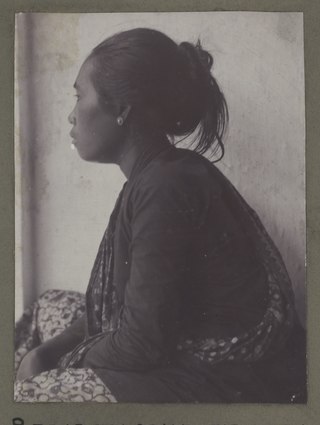
The Bawean, or Baweans, or also Baweanese, also called Bawean Madurese are an ethnic group native to the island of Bawean, located in the Java Sea off the coast of Java, Indonesia. They are considered a distinct ethnic group within the larger Javanese cultural sphere. The Bawean people have their own unique language, also called Bawean, which belongs to the Austronesian language family.

Indonesia is home to over 700 living languages spoken across its extensive archipelago. This significant linguistic variety constitutes approximately 10% of the world’s total languages, positioning Indonesia as the second most linguistically diverse nation globally, following Papua New Guinea. The majority of these languages belong to the Austronesian language family, prevalent in the western and central regions of Indonesia, including languages such as Acehnese, Sundanese, and Buginese. In contrast, the eastern regions, particularly Papua and the Maluku Islands, are home to over 270 Papuan languages, which are distinct from the Austronesian family and represent a unique linguistic heritage. The language most widely spoken as a native language is Javanese, primarily by the Javanese people in the central and eastern parts of Java Island, as well as across many other islands due to migration.
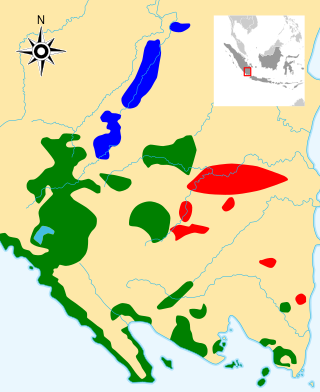
Lampung or Lampungic is an Austronesian language or dialect cluster with around 1.5 million native speakers, who primarily belong to the Lampung ethnic group of southern Sumatra, Indonesia. It is divided into two or three varieties: Lampung Api, Lampung Nyo, and Komering. The latter is sometimes included in Lampung Api, sometimes treated as an entirely separate language. Komering people see themselves as ethnically separate from, but related to, Lampung people.
Kangean is a Austronesian language spoken by the Kangean people, which is an ethnic group native to Kangean Islands region, north of the Bali Sea. It is native to Kangean and the surrounding islands. The Kangean language is closely related to Madurese and partly mutually intelligible with it, and is often considered a dialect of Madurese.
Kulung is one of the Kiranti languages. It is spoken by an estimated 33,000 people. Van Driem (2001) includes Chukwa as a dialect.
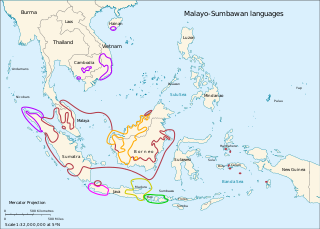
The Malayo-Sumbawan languages are a proposed subgroup of the Austronesian languages that unites the Malayic and Chamic languages with the languages of Java and the western Lesser Sunda Islands, except for Javanese. If valid, it would be the largest demonstrated family of Malayo-Polynesian outside Oceanic. The Malayo-Sumbawan subgroup is however not universally accepted, and is rejected e.g. by Blust (2010) and Smith (2017), who supported the Greater North Borneo and Western Indonesian hypotheses. In a 2019 paper published in Oceanic Linguistics, Adelaar accepted both of these groupings, in addition to Smith's (2018) redefinition of Barito languages as forming a linkage.

The Bali–Sasak–Sumbawa languages are a group of closely related languages spoken in Indonesia in the western Lesser Sunda Islands. The three languages are Balinese on Bali, Sasak on Lombok, and Sumbawa on western Sumbawa.

Pegon is a modified Arabic script used to write the Javanese, Sundanese, and Madurese languages, as an alternative to the Latin script or the Javanese script and the Old Sundanese script. It was used in a variety of applications, from religion, to diplomacy, to poetry. But today particularly, it is used for religious (Islamic) writing and poetry, particularly in writing commentaries of the Qur'an. Pegon includes letters that are not present in Modern Standard Arabic. Pegon has been studied far less than its Jawi counterpart which is used for Malay, Acehnese and Minangkabau.
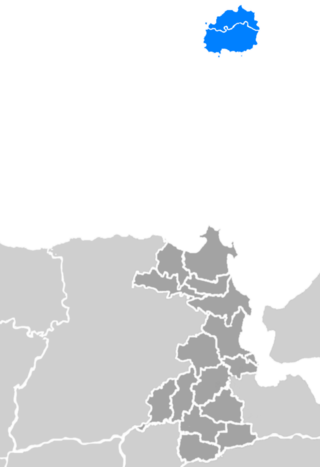
Bawean dialect, also known as Bawean language, is a dialect of Madurese language spoken predominantly by Bawean people in Bawean island. This dialect have 4 major sub-dialects each spoken predominantly in village of Daun and Suwari in the villages of Sangkapura, and the village of Kepuhteluk in the district of Tambak. As well as additional sub-dialects of Bawean Creole.

